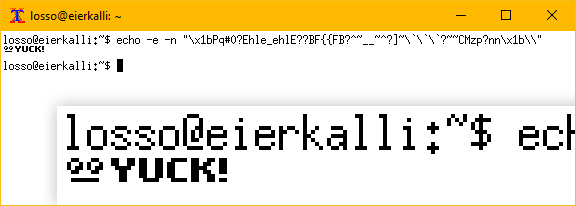Ah, the joys of confusing IT concepts and ambiguous names.
When I first read the word “sixels” in the context of Teletext graphics three years ago, that name immediately clicked with me, and I thought it fitting as a catchy combination of “pixel” and “six-element mosaic character”. I mean, it’s obviously exactly what you should call these little guys:
Today I learned that “sixel graphics” is also used in a very different context, describing a special graphics mode of oldschool terminals and dot matrix printers. Here, sixels aren’t the elements of a tiny 2×3 grid, but a vertical row of six dots! Since it can be used to display graphical data in your terminal, it’s widely used even today. You only need a bunch of arcane ESC-sequence incantations:
‹ESC›Pq#0?Ehle_ehlE??BF{{FB?^~__~^?]~```?~~CMzp?nn‹ESC›\
Easy, right? Dump that garbage right into your terminal:

Luckily, there’s no room for debate on which concept denotes the true sixels!
- Teletext went live in 1974
- That “SIXEL graphics” hack came years after that – around 1983 apparently, with the introduction of the DEC LA-50 printer
So, go have fun with your shenanigangs in those newfangled terminal emulators, but keep your ugly ESC sequences off my TV screen! And maybe invent a better name, while you’re at it. How about “POOP” – pixel obfuscation for obsolete printers? :)